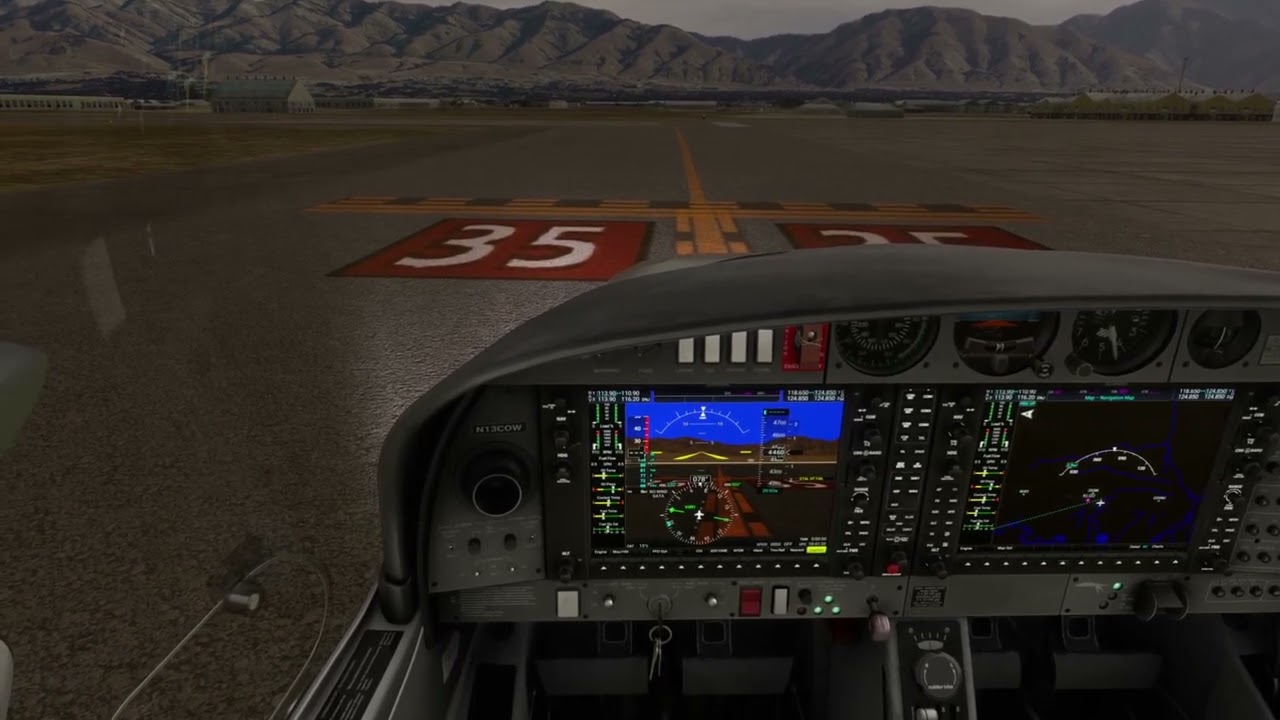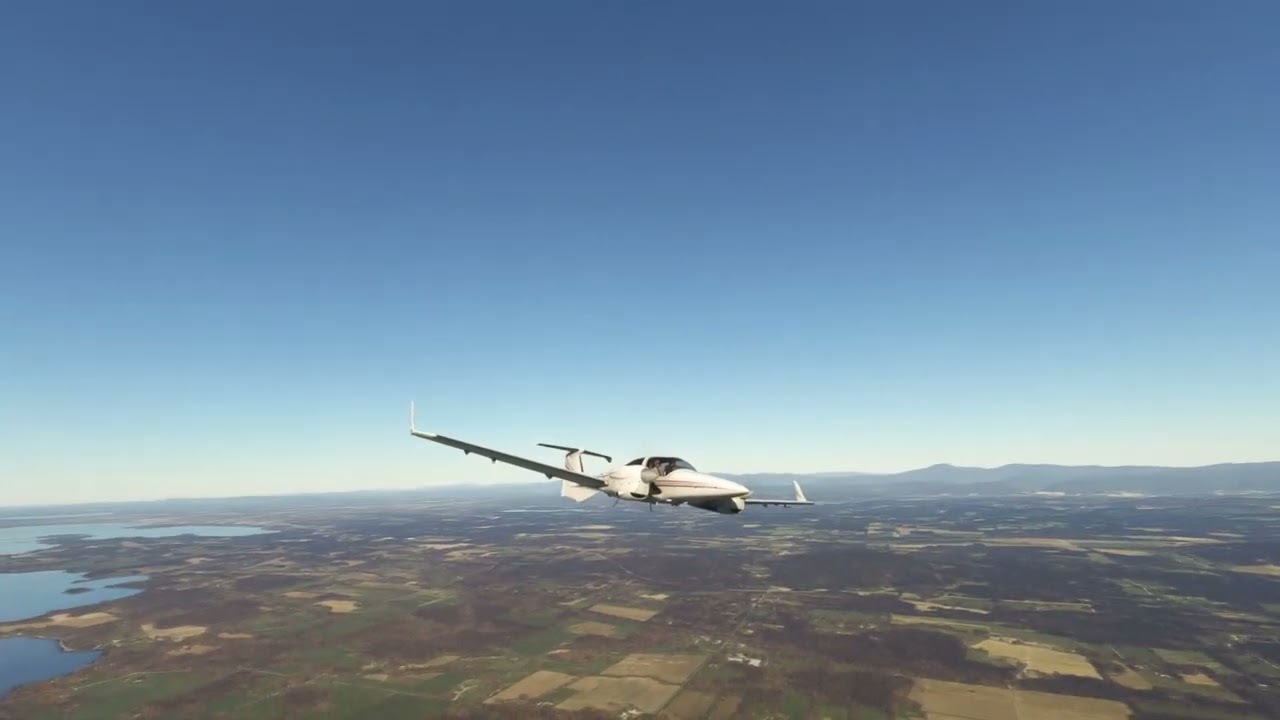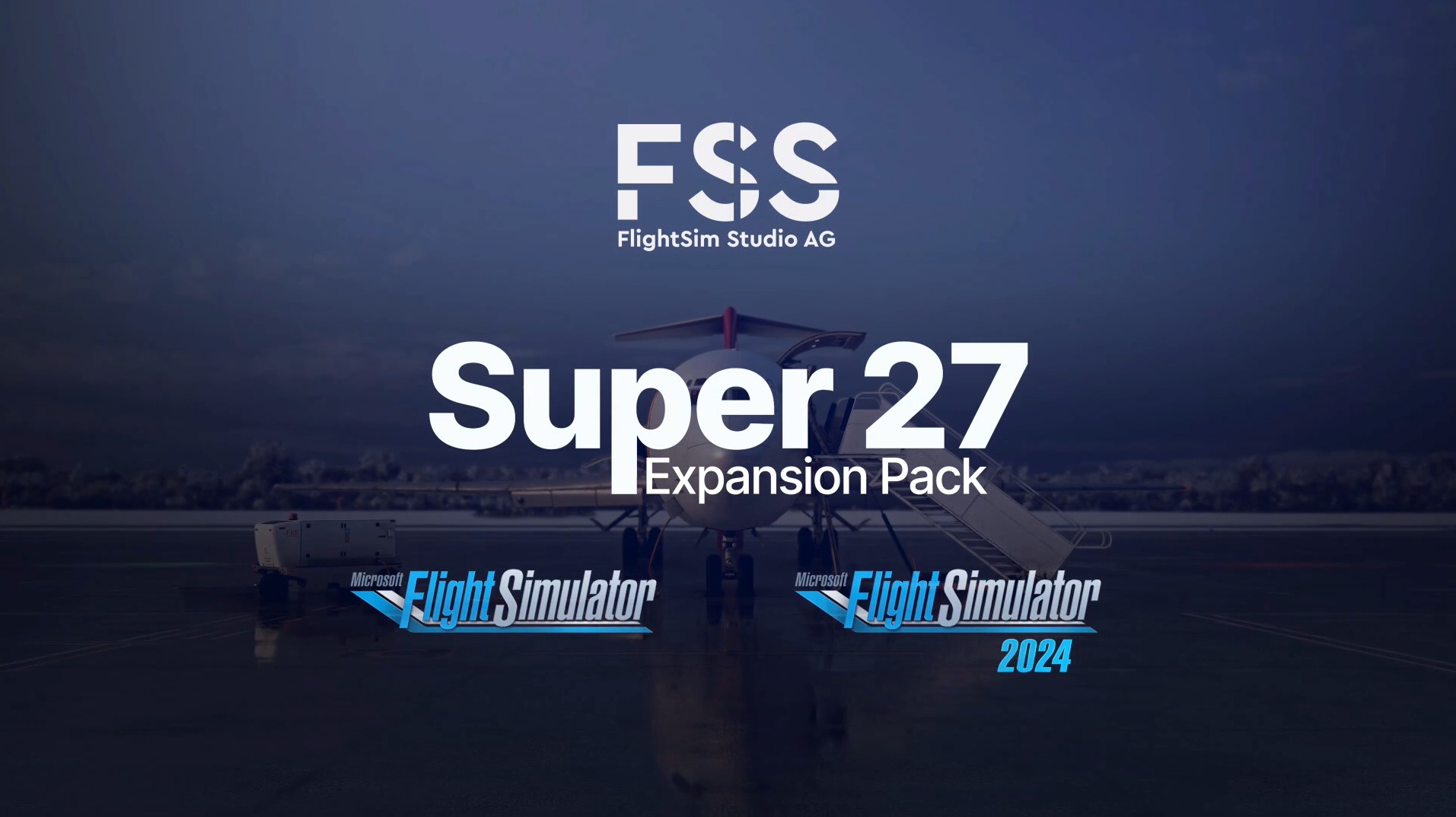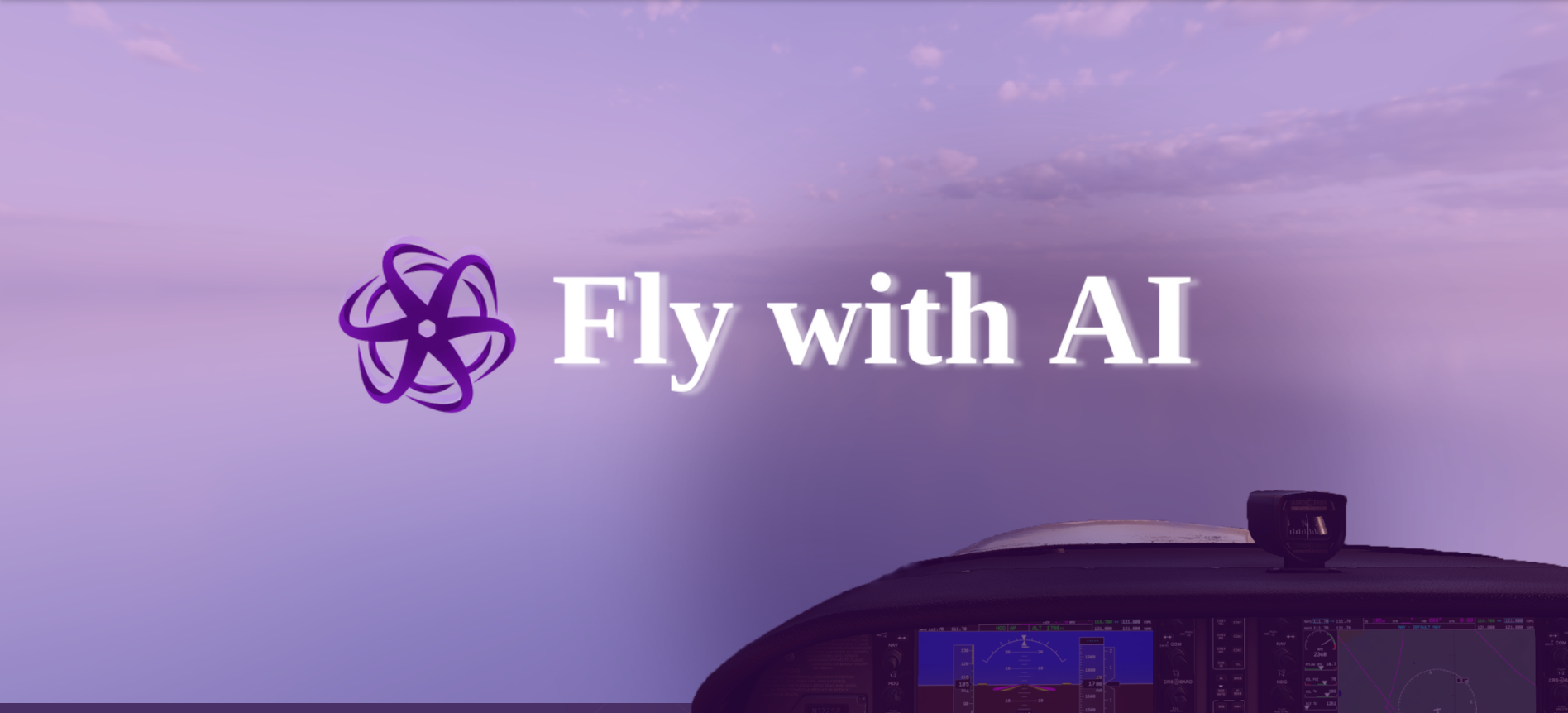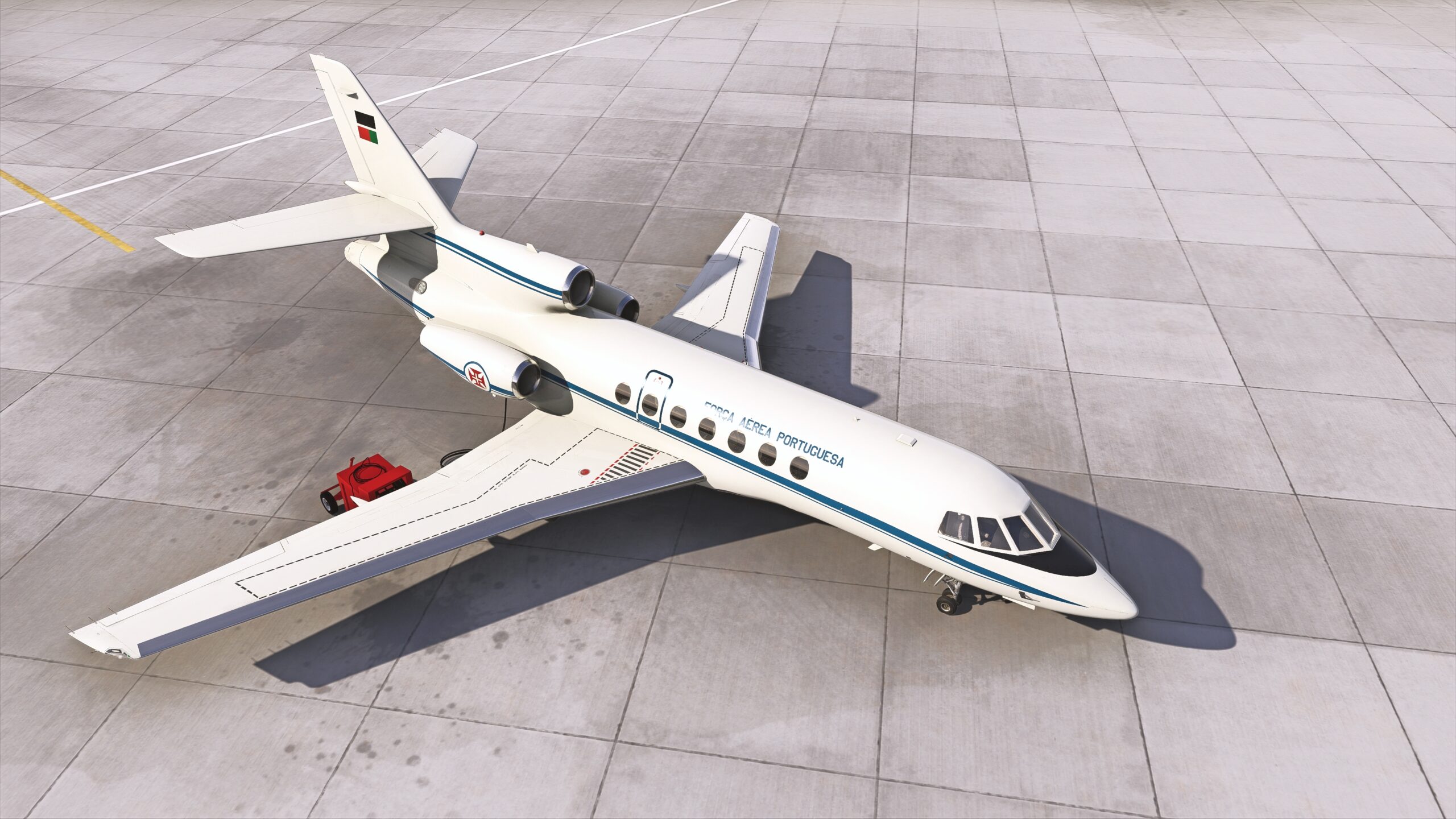The COWS DA42 for Microsoft Flight Simulator was released in late February as the first release from the burgeoning COWS (Creator Of WorldS) development studio. Today, we will review their Diamond DA42 “Twin Star.” It is the latest entry into a growing catalog of high-fidelity general aviation aircraft that already has quite a few spectacular entries.
So how does a new studio distinguish itself in a competitive market? With the Diamond DA42, COWS has given us a definitive answer: By delivering a stunning rendition of a thoroughly modern aircraft, and by replicating the modern systems with just as much life and care as others have done for the older aircraft. The COWS DA42 for MSFS is a worthy addition to the GA catalog and a spectacular way for a new studio to make its mark.
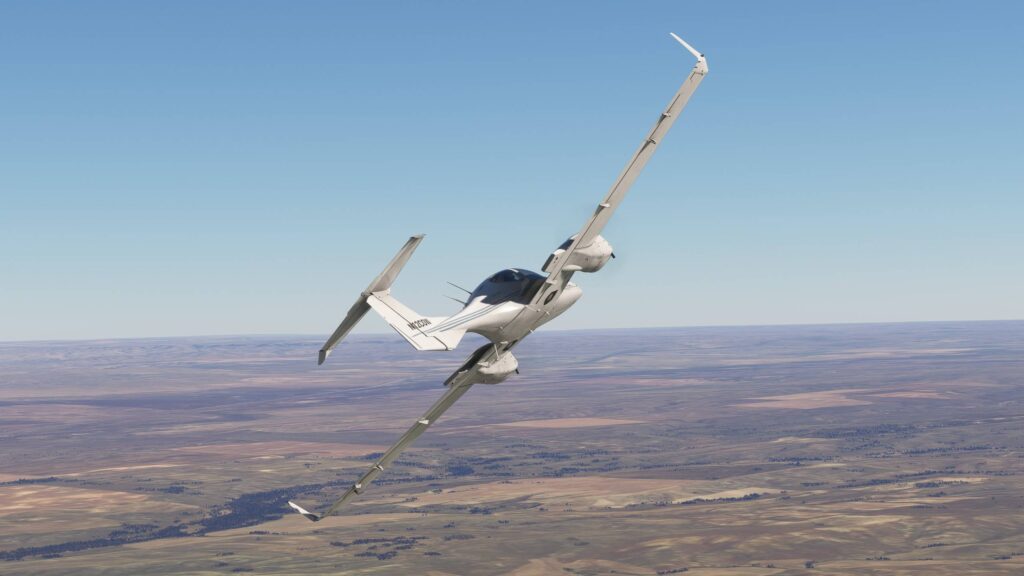
COWS DA42 Review Setup
This review of the COWS DA42 for Microsoft Flight Simulator was performed on a PC copy of MSFS. For context on performance, my PC is equipped with an AMD Ryzen 5800X3D, RTX 3080, and 64GB of RAM. I sim on an ultrawide monitor and used the Thrustmaster TCA Airbus joystick, Honeycomb Bravo throttle, and Thrustmaster TFRP pedals as well as a Tobii 5 Eye Tracker to conduct the review.
I am a licensed private pilot in the United States, but hold no multiengine rating. The review copy of the COWS DA42 was provided to FSNews by our media partners at Orbx. However, the opinions and conclusions presented in this review are mine alone and have not in any way been influenced by COWS (Creator Of WorldS) or Orbx.
A Diamond in the Rough
Diamond Aircraft was founded in 1981 and is headquartered in Austria. They produce a wide range of general aviation aircraft with a modern design philosophy. By utilizing groundbreaking construction techniques and composite airframes, combined with highly efficient engines, Diamond aircraft are instantly recognizable on the ramp – looking positively futuristic next to Pipers and Cessnas.

The Diamond DA42 is powered by two diesel reciprocating piston engines – either the Thielert/Technify Motors TAE125-02-99 (TDi variant) or Austro E4-C (NG Variant). The diesel engines can be fueled with Jet-A and are central to the DA42’s hallmark efficiency, consuming approximately the same amount of fuel per hour combined as older piston singles running on 100LL Avgas. Luxuriously appointed with a wrap-around canopy and high-tech avionics, the DA42 is a pilot’s dream as well. The same efficient engines deliver legendary reliability for a light twin, and a FADEC (Full Authority Digital Engine Control) system ensures safe and simple operation.
The “Twin Star” was Diamond’s first twin-engine aircraft design. It has become popular as a trainer and personal aircraft, seating four in two rows. It has also gained popularity with several militaries, both as a primary twin-engine trainer and a dedicated surveillance aircraft as the DA42 MPP – a role in which it has excelled.
Installation and Setup
The COWS Diamond DA42 is available for Microsoft Flight Simulator at a cost of $30.67 USD. A version is in development for X-Plane 12 but does not yet have a release date. The add-on is currently available only for PC via the Orbx online store. It is installed and managed through Orbx Central and installation is therefore straightforward.

Two variants are included: the older DA42-TDi with Thielert engines and the DA42-VI (NG – New Generation) with Austro engines. Documentation is provided in the form of official Aircraft Flight Manuals for each variant. The only issue is that the “Documentation” link in Orbx Central does not point to anything; however, the documentation is easily accessible in the aircraft’s installation folder. Providing official AFMs is awesome, but does come with some drawbacks: First, it is not as accessible to an inexperienced pilot who might not understand how to read and understand the format. Second, they are provided as links to Diamond’s own documentation, which means if Diamond ever removes or changes the source, that link breaks for the customer.
A few simple liveries are included for each variant – nothing fancy, but they represent factory liveries and support custom registrations. A free livery pack is available from Orbx, including several liveries representing flight schools across the world – some of the DA42’s largest customers. An official paintkit is available for livery creators as well.
Visual Victory
The COWS DA42 for MSFS may be the first release from these developers, but they have not held anything back. The COWS DA42 looks excellent from every angle and reflects the faithful effort that the COWS team has put into the product. Performance, too, was excellent. I noticed no major frame drops or hitches that I could directly attribute to the COWS DA42. However, it was approximately 3-5 FPS slower on average than default GA twin aircraft – a reduction that makes it “heavy” for a GA aircraft but is not noticeable unless you’re already strapped for performance.
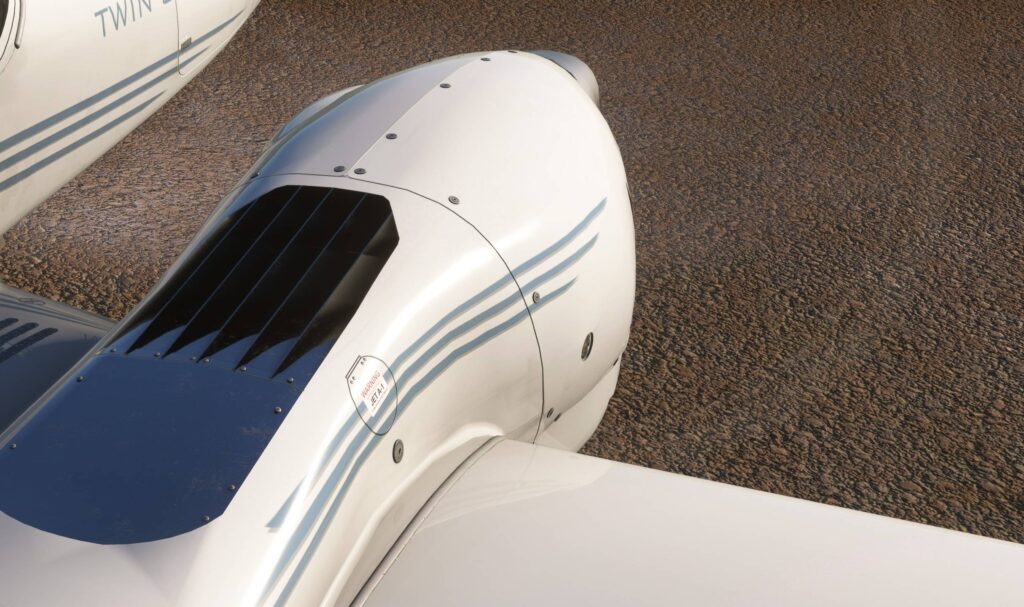
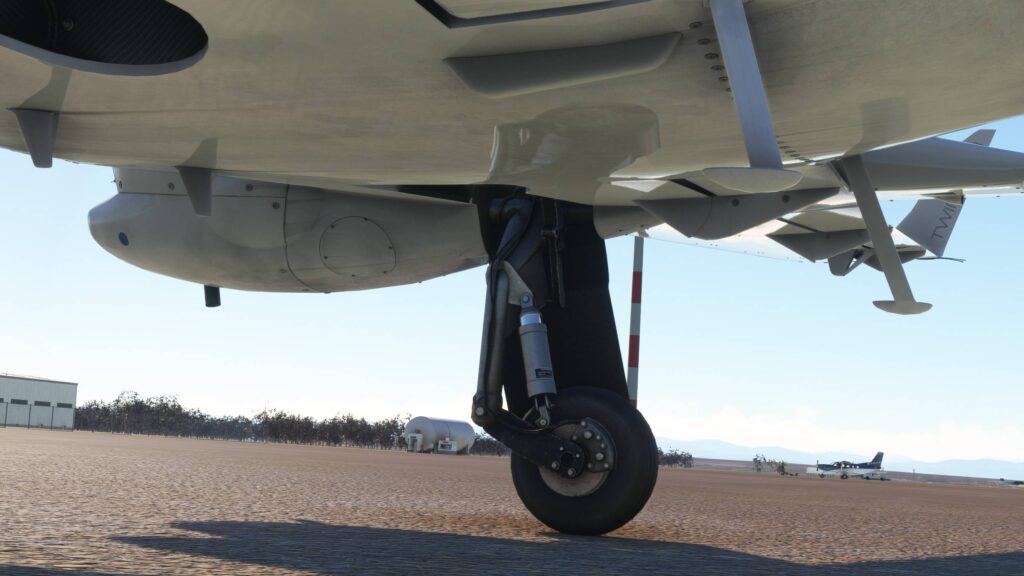


Externals
Both DA42 variants have unique models to match. The primary differences are in the engine nacelles. Although they are similar at a glance it’s easy to see the difference. Diamond’s sleek, composite construction is well-represented here, and the model is accurate to the reference photos I could find. While composite aircraft in MSFS can often come out overly shiny, COWS has done an excellent job of “tempering” this tendency with clever texturing and subtle weathering effects.
There are a few areas to improve. In particular, some areas on the DA42-VI’s engine cowlings have some odd polygons that result in peculiar shadows in certain lighting conditions. This is, unfortunately, visible from the cockpit and is the one noticeable blemish on an otherwise excellent creation.


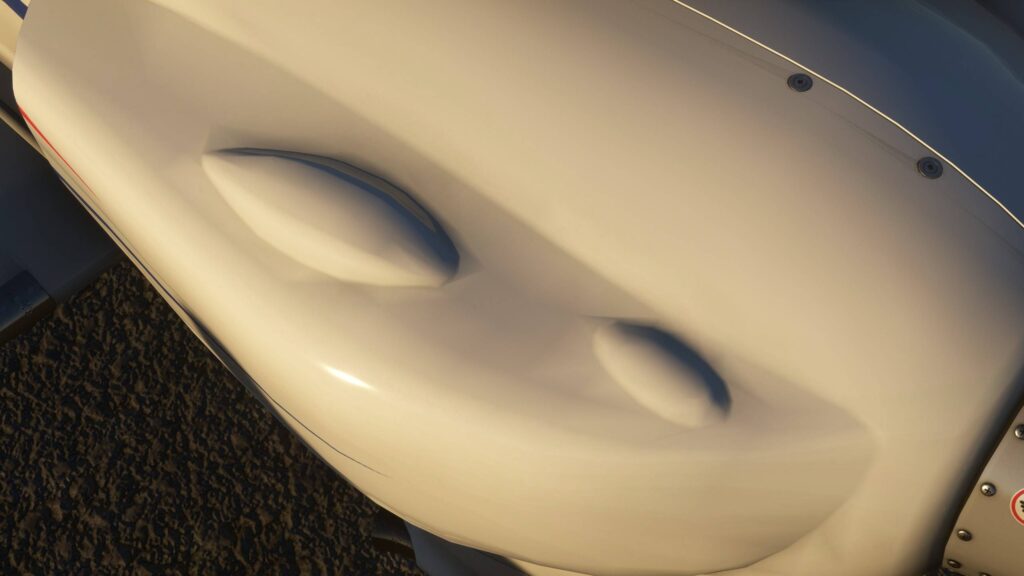
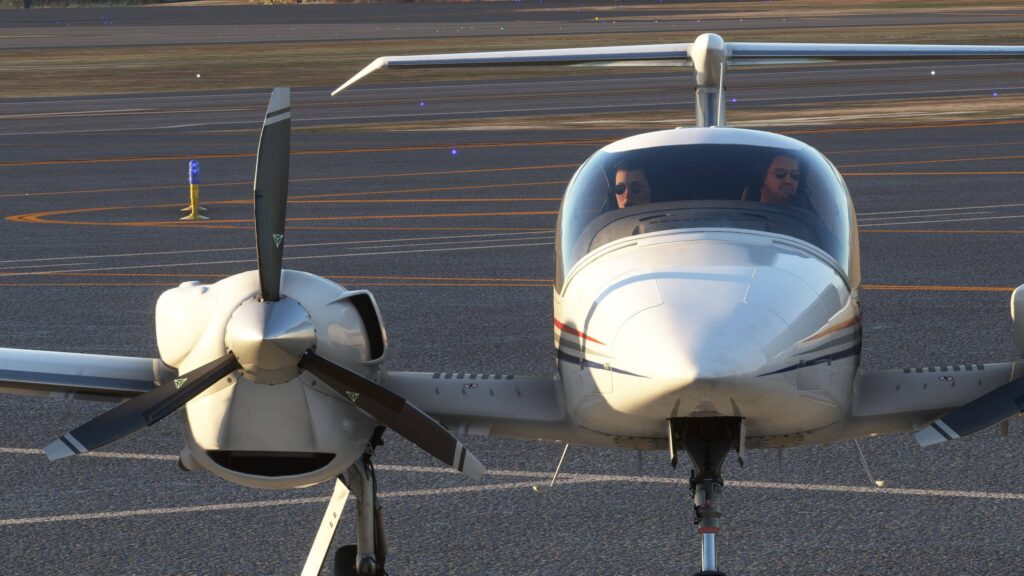
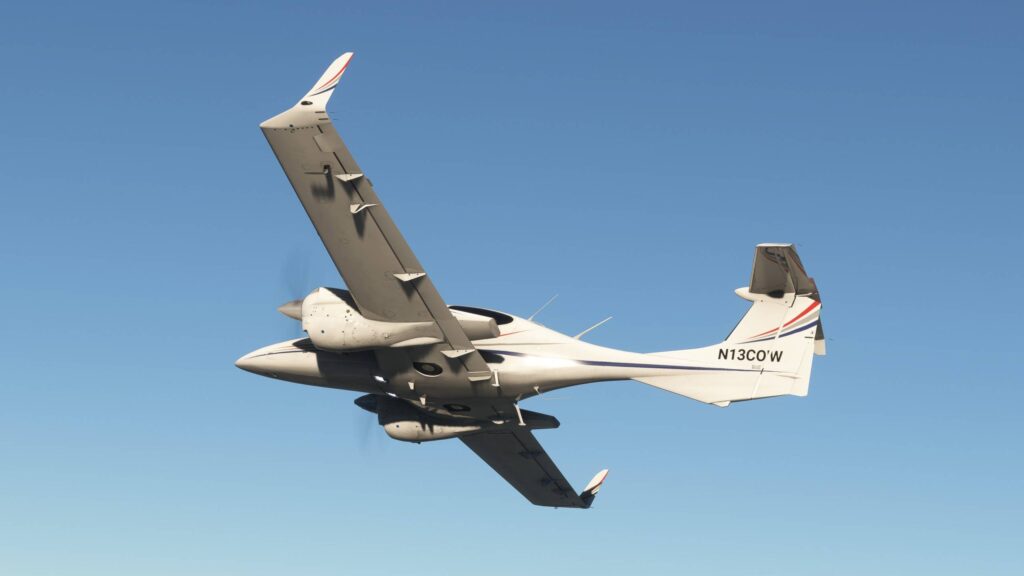
Cabin
I can find no major issues with the cabin of the COWS DA42. Material textures on the seats, glare shield, and cabin are excellent, with a real tactile feel that is a pleasure to look at over long cruises. There is a wonderful three-dimensional depth to the cockpit that is complemented beautifully by the panoramic windshield. I could nitpick – the keys don’t swing with the pitch and roll of the aircraft – but what would that accomplish?



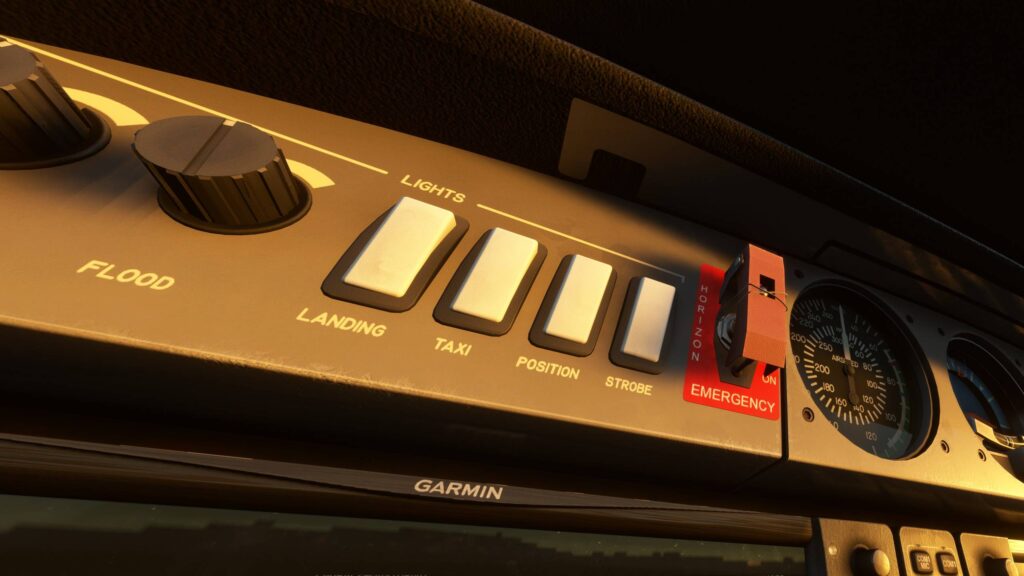

Both inside and out, the animations are excellent. In particular, the landing gear feels more lively than most other aircraft in the simulator. The compression is simulated to a particularly excellent degree, with the aircraft sitting differently depending on how weight is distributed within the aircraft. I love the dynamic way the aircraft rolls and “dives” on aggressive braking, reminding me to stay smooth and gentle. The elevator linkages are also particularly nice to watch in action, and the propeller discs are smooth and realistic from both the external and cockpit views.
Sonic Success
I knew it was something special when I stepped into the COWS Diamond DA42. The COWS team has delivered a unique soundscape for both variants of the DA42, with excellent reproduction of both engine sounds as well as ambient and equipment noise. There are a couple of rough edges, however. In cruise, it is easier to notice the looping effect of the engine sounds, and when using my eye tracker, it felt like the left and right sounds were reversed when moving my head. I did not notice this when using the mouse to look around the cockpit. These, though, are minor issues that did not detract from the experience I had.
Sound Examples
Fantastic Flying
The Diamond DA42 is a new generation of light twin. Its high-aspect-ratio wing and powerful engines give it a degree of stability and safety unlike anything else in the general aviation market. It is stable and forgiving, but large control surfaces keep it responsive to control inputs.
The COWS DA42 for MSFS flies exactly as described in the manuals. Besides hitting book numbers, COWS has managed to nail the feel of flying it as told by Diamond pilots, though I have not been privileged enough yet to fly one myself. It’s extremely stable and easy to control in all phases of flight. Landing flare is forgiving, and it’s easy to control the point of touchdown with the controlled application of power.
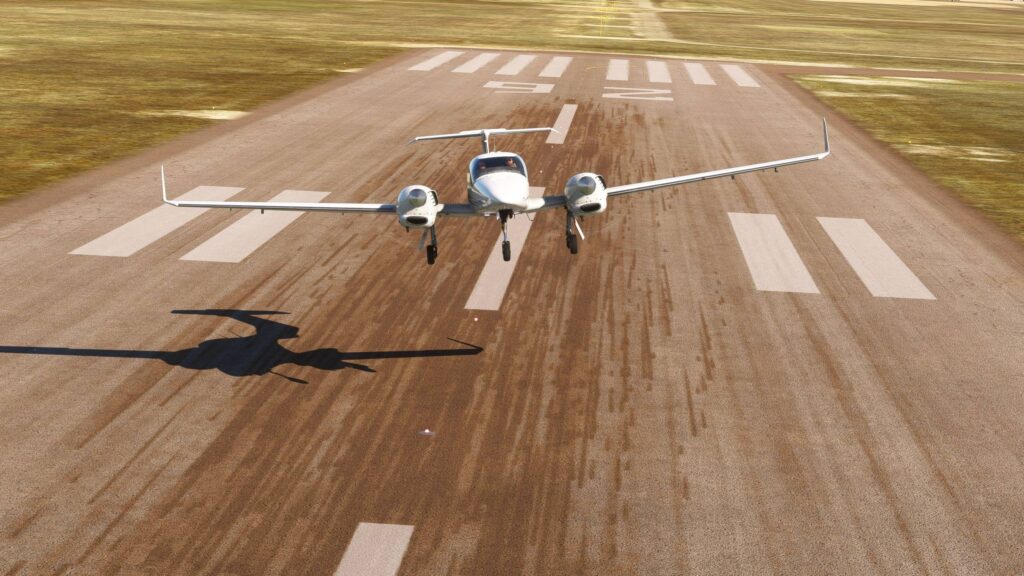
And speaking of power, the COWS DA42 is easily lifted into the sky by its twin engines – or single engine, should one fail. Light twins have historically been described as having enough power on one engine to “fly you to the scene of the crash” – but this is a trend that Diamond has halted. The advertised single-engine service ceiling – the altitude at which the aircraft climbs at 50fpm or less on a single engine at max power – is advertised by Diamond as being 16,000 feet. In simulator testing, this is accurate. At lower altitudes, it is often difficult to notice even a significant reduction in power on a single engine. At least until the FADEC shuts down and auto-feathers the offender.
Single-engine operations are further enhanced by COWS’ faithful reproduction of the DA42’s flight characteristics. The left engine is critical, and you can feel a difference in the amount of single-engine yaw if the left engine fails vs. the right. When approaching Vmc (Minimum Controllable Airspeed on a single engine) and dropping below it, the DA42 does not snap into an uncontrollable roll like other light twins, a testament to the aircraft’s large rudder and safe design. Other regimes of flight, such as stalls and slow flight, feel distinct and accurate to the handling descriptions I could find.
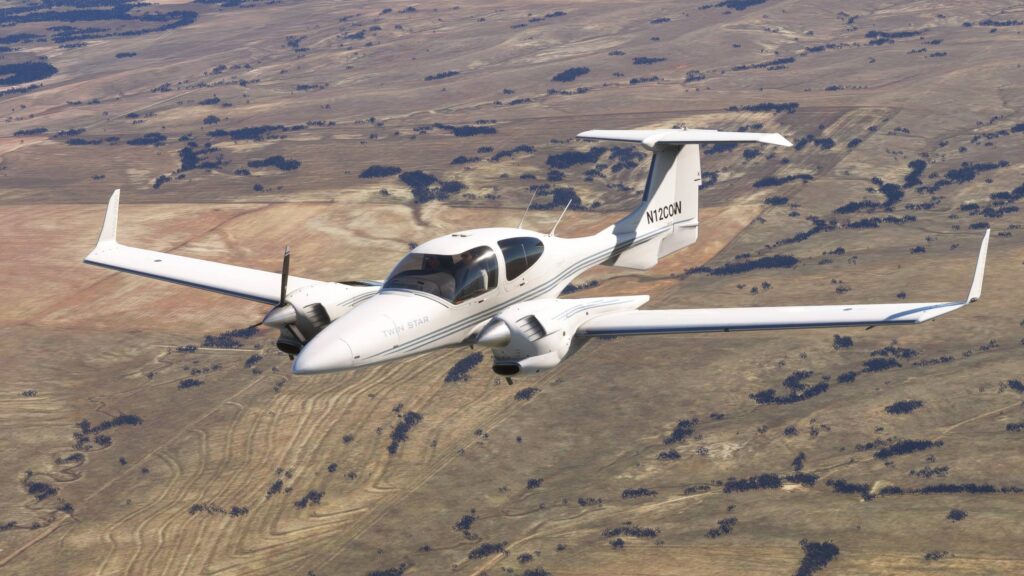
During my review, the COWS DA42 flew with life and excitement, which is high praise in a sim often accused of flying as if it was on rails. While the DA42 has an autopilot, I would encourage pilots to turn it off and fly by hand to enjoy the thrill that it offers. You’ll find that it gives you what you need and never complains.
Systems Success
The core of the COWS DA42 for MSFS is a customized Working Title G1000NXi, augmented by COWS’ own systems design. The only bug that I found in the systems of the COWS DA42 was that sometimes the MFD (Multi-Function Display) would fail to initialize properly, forcing a sim restart – but this bug is endemic to the Working Title avionics, and will be fixed in Sim Update 15.

Fortunately, that was the only fault in an otherwise excellent rendition of the DA42’s systems. This aircraft is highly automated, and many simmers deride that automation as “boring.” That can be the case with some implementations that treat the glass cockpit and FADEC systems as a black box that blindly spits out the “correct” numbers when matched with a set of inputs. However, when the workings of the systems are actually simulated (as COWS has done with the DA42) it can be just as exciting and lively as analog aircraft.
Let me explain a little further. Glass-cockpit avionics and a FADEC (Full Authority Digital Engine Control) system combine many systems into one, eliminating manual tasks such as adjusting the mixture and correcting gyro drift. The underlying phenomena and processes that these avionics control, however, are still very physical, and when that physicality is simulated, a glass cockpit aircraft can come alive in the simulator.
Let’s talk about the hydraulic landing gear. When the aircraft powers up, that system must be pressurized, and you can hear the electric pump spinning at startup to do so. The manual states that you’ll hear the pump running for approximately 4-6 seconds as the system comes up to the correct pressure. An add-on that “ticked the boxes” would always run the pump for 4-6 seconds upon startup, and that’s it. But the COWS DA42 actually simulates the pressure in the system and runs the pump accordingly: if you fully pressurize the gear, turn the aircraft off, and then back on, you’ll only hear the pump blip on briefly since the hydraulics are already fully pressurized.
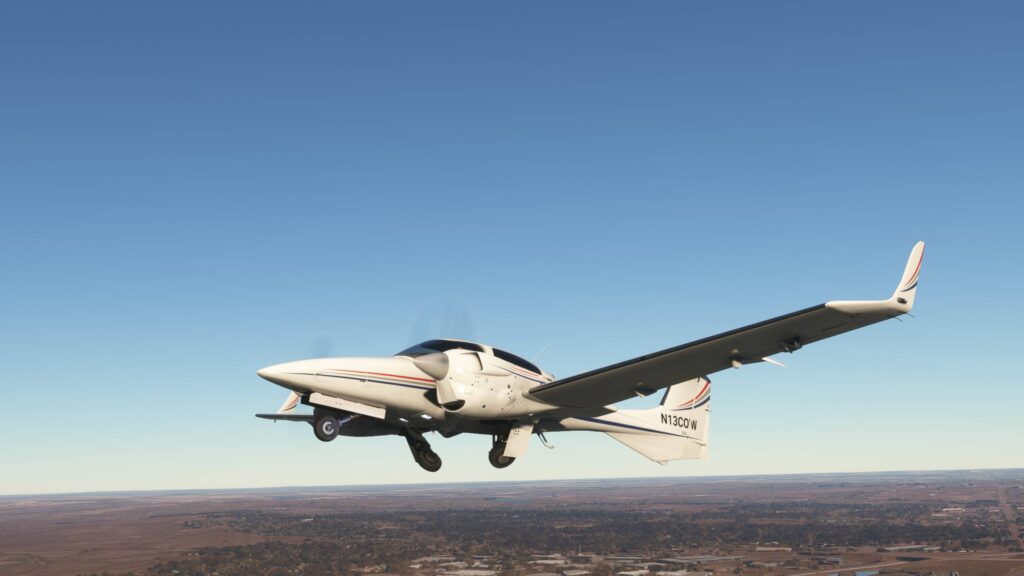
This seems like a small thing, and indeed, hydraulic systems simulations are an expectation for high-fidelity airliners. But it has become a habit in the sim world for aircraft with advanced avionics to simply stick to the book numbers and abstract the physical simulation behind the pretty numbers on screen – leaving the “high fidelity simulation” to the best analog aircraft since that simulation is easier to see. COWS has not fallen into that trap. Instead, they deliver engaging and accurate systems simulation at every turn, resulting in more life and excitement than just about any other G1000 aircraft in my hangar.
A couple of quick notes to wrap up this section: the COWS DA42 does model engine wear and includes cockpit persistence per tail number, both excellent features. These are disabled by default for ease of understanding. They are enabled through a convoluted manipulation of the ECU Test buttons and ECU voter switches, but this is explained clearly in the manual. COWS has consciously elected to not add any form of EFB (although a tablet is modeled in the side pocket), and while I respect this decision, it is undeniable that moving settings such as this to a tablet would make them easier to use.
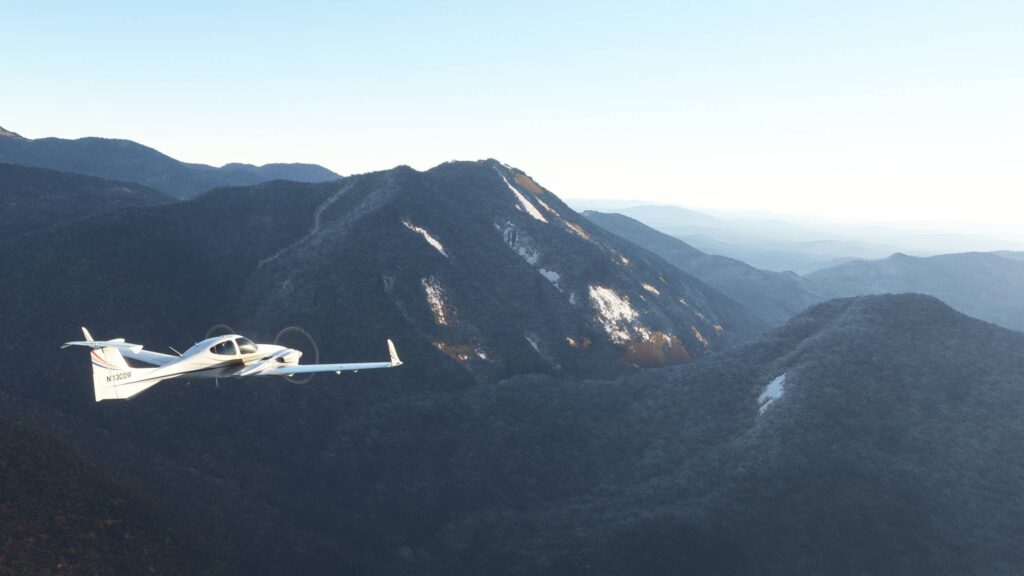
Conclusion
As I stated in the previous section, far too many people dismiss modern and automated aircraft, especially in a sim setting where safety and reliability can paradoxically be a detractor. “FADEC is boring” is a line that I hear far too often, coming from simmers to whom flying by analog instruments is the only “acceptable” way to enjoy the sim.
The COWS Diamond DA42 has proven that this is not the case. Glass cockpit, FADEC-equipped, modern aircraft are exciting in the simulator when they are delivered with the same finesse and attention to detail that their analog brethren receive. The DA42 on offer here is a prime example of this: it’s an aircraft that feels alive and affected by its environment, flies smoothly, looks great, and sounds superb.
COWS has entered the pantheon of the best GA aircraft for MSFS, and they’ve done it with a loud and resounding “MOO!” Sit back and enjoy the automation while you enjoy our Sim Travel Guide, and let the aircraft do the work. The COWS DA42 now enjoys a special place in my hangar, and I highly recommend considering clearing a parking spot for it in yours.

Feel free to join our Discord server to share your feedback on the article, screenshots from your flights or just chat with the rest of the team and the community. Click here to join the server.

